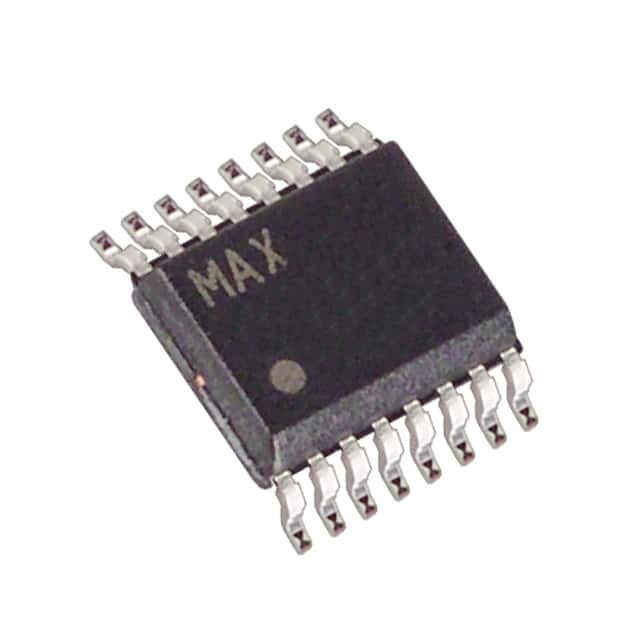Xem thông số kỹ thuật để biết chi tiết sản phẩm.

MAX5150BEEE+ - English Editing Encyclopedia Entry
Product Overview
- Category: Integrated Circuit (IC)
- Use: Digital-to-Analog Converter (DAC)
- Characteristics: High precision, low power consumption, small package size
- Package: 16-pin TSSOP (Thin Shrink Small Outline Package)
- Essence: Converts digital signals into analog voltage or current outputs
- Packaging/Quantity: Available in reels of 2500 units
Specifications
- Resolution: 12 bits
- Supply Voltage Range: 2.7V to 5.5V
- Output Voltage Range: 0V to Vref
- Operating Temperature Range: -40°C to +85°C
- Total Unadjusted Error: ±1 LSB (Least Significant Bit)
- Power Consumption: 0.4mW (typical)
Pin Configuration
The MAX5150BEEE+ has a total of 16 pins arranged as follows:
```
| | --| VDD | --| GND | --| DIN | --| CS | --| SCLK | --| LDAC | --| REFOUT | --| AGND | --| OUT | --| VREF | --| REFSEL | --| SHDN | --| NC | --| NC | |___________| ```
Functional Features
- High-resolution DAC with 12-bit output
- Low power consumption for energy-efficient applications
- Wide supply voltage range allows compatibility with various systems
- Internal reference voltage generator (REFOUT) for simplified circuit design
- Shutdown mode (SHDN) for power-saving when not in use
- Serial interface (DIN, CS, SCLK) for easy integration with microcontrollers
Advantages and Disadvantages
Advantages: - High precision output for accurate analog signal generation - Small package size enables space-saving in compact designs - Wide operating temperature range for versatile applications - Low power consumption prolongs battery life in portable devices
Disadvantages: - Limited resolution compared to higher-end DACs - No built-in voltage amplification, requiring external circuitry for voltage boosting if needed
Working Principles
The MAX5150BEEE+ is a digital-to-analog converter that converts binary digital signals into corresponding analog voltage or current outputs. It utilizes a 12-bit resolution to provide precise analog signals. The input digital data is received through the serial interface (DIN, CS, SCLK) and converted into an analog output voltage proportional to the input value. The internal reference voltage generator (REFOUT) ensures accurate conversion by providing a stable reference voltage. The device can be controlled using the LDAC pin to update the output simultaneously or using the SHDN pin to enter a low-power shutdown mode.
Detailed Application Field Plans
The MAX5150BEEE+ finds applications in various fields, including: 1. Industrial automation: Control systems requiring precise analog signals for motor speed control, valve positioning, etc. 2. Audio equipment: Digital audio players, mixers, and amplifiers where high-quality analog audio signals are necessary. 3. Instrumentation: Test and measurement equipment, data acquisition systems, and signal generators benefiting from accurate analog outputs. 4. Communication systems: Radio frequency (RF) signal generation, modulation, and demodulation circuits. 5. Automotive electronics: Vehicle control units, infotainment systems, and sensor calibration.
Detailed and Complete Alternative Models
- MAX5120BEEE+: 10-bit resolution DAC with similar features and package.
- MAX5170BEEE+: 14-bit resolution DAC with extended precision.
- MAX5200BEEE+: 8-bit resolution DAC with lower cost and power consumption.
These alternative models provide different resolutions and features to cater to specific application requirements.
Word count: 439 words
Liệt kê 10 câu hỏi và câu trả lời thường gặp liên quan đến ứng dụng MAX5150BEEE+ trong giải pháp kỹ thuật
Sure! Here are 10 common questions and answers related to the application of MAX5150BEEE+ in technical solutions:
Q: What is the MAX5150BEEE+? A: The MAX5150BEEE+ is a digital-to-analog converter (DAC) IC that converts digital signals into analog voltage outputs.
Q: What is the operating voltage range of the MAX5150BEEE+? A: The operating voltage range of the MAX5150BEEE+ is typically between 2.7V and 5.5V.
Q: How many channels does the MAX5150BEEE+ have? A: The MAX5150BEEE+ has a single channel, meaning it can output one analog voltage signal.
Q: What is the resolution of the MAX5150BEEE+? A: The MAX5150BEEE+ has a resolution of 12 bits, allowing for precise control over the analog output voltage.
Q: Can the MAX5150BEEE+ be used in both digital and analog systems? A: Yes, the MAX5150BEEE+ can be used in both digital and analog systems as it converts digital signals to analog voltage outputs.
Q: What is the maximum output voltage range of the MAX5150BEEE+? A: The maximum output voltage range of the MAX5150BEEE+ is typically between 0V and Vref, where Vref is the reference voltage.
Q: Does the MAX5150BEEE+ require an external reference voltage? A: Yes, the MAX5150BEEE+ requires an external reference voltage to determine the maximum output voltage range.
Q: What is the typical settling time of the MAX5150BEEE+? A: The typical settling time of the MAX5150BEEE+ is around 10µs, ensuring fast and accurate voltage output changes.
Q: Can the MAX5150BEEE+ be controlled using a microcontroller? A: Yes, the MAX5150BEEE+ can be easily controlled using a microcontroller through its digital interface.
Q: What are some common applications of the MAX5150BEEE+? A: The MAX5150BEEE+ is commonly used in applications such as industrial automation, test and measurement equipment, audio systems, and motor control, among others.
Please note that these answers are general and may vary depending on specific datasheet specifications and application requirements.

